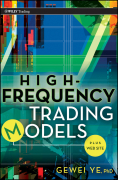
INDICE: Preface. Part I: Revenue Models of High-Frequency Trading. Chapter 1: High-Frequency Trading and Existing Revenue Models. What Is High-Frequency Trading? Why High-Frequency Trading Is Important. Major High-Frequency TradingFirms in the U.S. Existing Revenue Models of High-Frequency Trading Operations. Categorizing High-Frequency Trading Operations. Conclusion. Chapter 2: Roots of High-Frequency Trading in Revenue Models of Investment Management. Revenue Model 1: Investing. Revenue Model 2: Investment Banking. Revenue Model 3: Market Making. Revenue Model 4: Trading. Revenue Model 5: Cash Management. Revenue Model 6: Mergers and Acquisitions. Revenue Model 7: Back-office Activities.Revenue Model 8: Venture Capital. Creating Your Own Revenue Model. How to Achieve Success: Four Personal Drivers. Conclusion. Chapter 3: History and Futureof High-Frequency Trading with Investment Management. Revenue Models in the Future. Investment Management and Financial Institutions. High-Frequency Trading and Investment Management. Technology Inventions to Drive Financial Inventions. The Ultimate Goal for Models and Financial Inventions. Conclusion. Part II: Theoretical Models as Foundation of Computer Algos for High-Frequency Trading. Chapter 4: Behavioral Economics Models on Loss Aversion. What Is Loss Aversion? The Locus Effect. Theory and Hypotheses. Study 1: The Locus Effect on Inertia Equity. Study 2: Assumption A1 and A2. General Discussion. Conclusion. Chapter 5: Loss Aversion in Option Pricing: Integrating Two Nobel Models. Demonstrating Loss Aversion with Computer Algos. Visualizing the Findings. Computer Algos for the Finding. Explaining the Finding with the Black-Scholes Formula Conclusion. Chapter 6: Expanding the Size of Options in Option Pricing. The NBAEvent. Web Data. Theoretical Analysis. The NBA Event and the Uncertainty Account. Controlled Offline Data. General Discussion. Conclusion. Chapter 7: Multinomial Models for Equity Returns. Literature Review. A Computational Framework: The MDP Model. Implicit Consumer Decision Theory. Empirical Approaches. Analysis 1: Examination of Correlations and a Regression Model. Analysis 2: Structural Equation Model. Contributions of the ICD Theory. Conclusion. Chapter 8: More Multinomial Models and Signal Detection Models for Risk Propensity. Multinomial Models for Retail Investor Growth. Deriving Implicit Utility Functions. Transforming Likeability Rating Data into Observed Frequencies. Signal Detection Theory (SDT). Assessing a Funds Performance with SDT. Assessing Value at Risk with Risk Propensity of SDT for Portfolio Managers. Defining Risk Propensity Surface. Conclusion. Chapter 9: Behavioral Economics Models on Fund Switching and Reference Prices. What Is VisualFunds for Fund Switching? Behavioral Factors That Affect Fund Switching. Theory and Predictions.
- ISBN: 978-0-470-63373-1
- Editorial: John Wiley & Sons
- Encuadernacion: Cartoné
- Páginas: 336
- Fecha Publicación: 15/12/2010
- Nº Volúmenes: 1
- Idioma: Inglés
